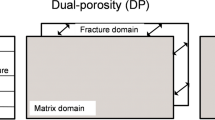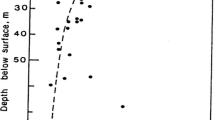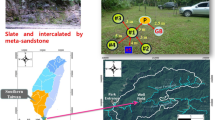Abstract
Fractured till is often represented as an equivalent porous medium (EPM) in groundwater models. Knowledge of the representative elementary volume (REV) is necessary for proper application of an EPM model. While REV estimation and hydraulic conductivity tensor determinations are common in fractured rock studies, they are rarely applied to materials with a permeable matrix such as fractured till. This study uses field fracture measurements, model simulations, and the FracKFinder toolbox to estimate the REV and determine hydraulic conductivity tensors for the fractured, late Wisconsinan till of the Dows Formation in central Iowa (USA), at depths of 1.0–1.5, 2.0–2.5, and 3.3–3.7 m. Results indicate that the REV of the till is directly related to both fracture density and transmissivity. REV size ranges from 4 to 5 m3 at depths of 1–2 m, where fractures are densest (P32 27.5 m2/m3) and most transmissive, to 2–3 m3 at depths of 3.3–3.7 m where fractures are least dense (P32 24.4 m2/m3) and least transmissive. Fracture hydraulic conductivity is five, four, and three orders of magnitude greater than matrix hydraulic conductivity at the shallowest to deepest depths of investigation, respectively. The results also suggest that hydraulic conductivity values estimated from permeameters and large-core laboratory experiments may not be of sufficient volume to represent the REV of fractured till.
Résumé
La moraine fracturée est souvent représentée comme un milieu poreux équivalent (MPE) dans les modèles numériques d’écoulement des eaux souterraines. La connaissance du volume élémentaire représentatif (VER) est nécessaire à la bonne application d’un modèle MPE. Bien que l’estimation du VER et les déterminations du tenseur de conductivité hydraulique soient courantes dans les études sur les roches fracturées, elles sont rarement appliquées aux matériaux ayant une matrice perméable, comme la moraine fracturée. Cette étude utilise des mesures de fracture sur le terrain, des simulations numériques, et la boîte à outils FracKFinder pour estimer le VER et déterminer les tenseurs de conductivité hydraulique pour la moraine fracturée du Wisconsinien tardif de la Formation Dows dans le centre de l’Iowa (Etats-Unis d’Amérique), à des profondeurs de 1.0–1.5, 2.0–2.5 et 3.3–3.7 m. Les résultats indiquent que le VER de la moraine est directement lié tant à la densité des fractures qu’à sa transmissivité. La taille du VER va de 4 à 5 m3 à une profondeur de 1–2 m, où les fractures sont les plus denses (P32 27.5 m2/m3) et les plus transmissives, à 2–3 m3 à des profondeurs de 3.3–3.7 m où les fractures sont les moins denses (P32 24.4 m2/m3) et les moins transmissives. La conductivité hydraulique de fracture est supérieure de cinq, quatre et trois ordres de grandeur par rapport à la conductivité hydraulique de la matrice, respectivement des profondeurs d’investigation les plus faibles aux plus profondes. Les résultats suggèrent aussi que les valeurs de conductivité hydraulique estimées à partir de perméamètres et d’expériences de laboratoire sur de grandes carottes ne sont peut-être pas d’un volume suffisant pour représenter le VER de la moraine fracturée.
Resumen
El till fracturado a menudo se representa como un medio poroso equivalente (EPM) en los modelos de agua subterránea. El conocimiento del volumen elemental representativo (REV) es necesario para la correcta aplicación de un modelo EPM. Mientras que la estimación REV y las determinaciones de tensores de conductividad hidráulica son comunes en los estudios de roca fracturada, rara vez se aplican a materiales con una matriz permeable, como en un till fracturo. Este estudio utiliza mediciones de fracturas de campo, simulaciones de modelos y la herramientas FracKFinder para estimar el REV y determinar los tensores de conductividad hidráulica para las fracturas de la Formación Dows en el centro de Iowa (EE.UU.), a profundidades de 1.0–1.5, 2.0–2.5 y 3.3–3.7 m. Los resultados indican que el REV del till está directamente relacionado tanto con la densidad de fractura como con la transmisividad. El tamaño REV varía de 4 a 5 m3 a profundidades de 1–2 m, donde las fracturas son más densas (P32 27.5 m2/m3) y más transmisivas, a 2–3 m3 a profundidades de 3.3–3.7 m donde las fracturas son menos densas dense (P32 24.4 m2/m3) y menos transmisivas. La conductividad hidráulica de la fractura es cinco, cuatro y tres órdenes de magnitud mayor que la conductividad hidráulica de la matriz en las profundidades de investigación más bajas a más profundas, respectivamente. Los resultados también sugieren que los valores de conductividad hidráulica estimados a partir de permeámetros y experimentos de laboratorio a gran escala pueden no ser del volumen suficiente para representar el REV del till fracturado.
摘要
在地下水模型中,裂隙土通常用等效介质的方法来进行表征。想要正确运用等效介质模型,必须了解典型单元体的相关知识。虽然在裂隙岩石研究中典型单元体的评估和渗透系数张量的确定很常见,但它们却很少应用于具有渗透性基质的材料,如裂隙土。.
本研究运用了野外裂隙测量、模型模拟和FracKFinder工具箱,估算了1.0–1.5、2.0–2.5和3.3–3.7 m深处,Iowa中部(美国)Dows地层Wisconsinan晚期裂隙的典型单元体,并确定了渗透系数张量。结果显示,典型单元体与裂隙的密度和导水系数直接相关。在1–2m深度时,典型单元体大小在4–5 m3之间变化,在这个深度上裂隙最为密集(P32 27.5 m2/m3)且导水性最好;在3.3–3.7m深度时,的单元体的大小在2–3 m3之间变化,在这个地方裂隙密度最小(P32 24.4 m2/m3),导水性也最差。在调查的最浅至最深深度,裂隙渗透系数分别比基质渗透系数大5、4和3个数量级。结果还表明,由渗透仪和大型核心实验室实验估算的渗透系数值可能不足以表征裂隙土的典型单元体。
Resumo
O titilo fraturado é frequentemente representado como um meio poroso equivalente (MPE) nos modelos de águas subterrâneas. O conhecimento do volume elementar representativo (VER) é necessário para a aplicação apropriada de um modelo MPE. Embora a estimativa do VER e as determinações do tensor de condutividade hidráulica sejam comuns em estudos de rochas fraturadas, elas são raramente aplicadas aos materiais com uma matriz permeável, tal como tilitos fraturados. Esse estudo usa medidas de fraturas de campo, simulações de modelo, e a ferramenta FracKFinder para estimar o VER e para determinar os tensores de condutividade hidráulica para o fraturado, tilito Wisconsiano da Formação Dows na região central de Iowa (EUA), em profundidades de 1.0–1.5, 2.0–2.5, e 3.3–3.7 m. Os resultados indicam que o VER do tilito é diretamente relacionado à densidade e à transmissividade da fratura. O tamanho do VER varia de 4 a 5 m3 em profundidades de 1–2 m, onde as fraturas são as mais densas (P32 27.5 m2/m3) e as mais transmissivas, até de 2–3 m3 em profundidades de 3.3–3.7 m onde as fraturas são as menos densas (P32 24.4 m2/m3) e menos transmissivas. A condutividade hidráulica da fratura é cinco, quatro, e três ordens de magnitude maior do que a condutividade hidráulica da matriz nas mais rasas até as mais profundas profundidades de investigação, respectivamente. Os resultados também sugerem que os valores de condutividade hidráulica estimados a partir de permeâmetros e experimentos laboratoriais com grandes amostras podem não ter volume suficiente para representar o VER de tilitos fraturados.







Similar content being viewed by others
References
Anderson M, Woessner W, Hunt R (2015) Applied Groundwater Modeling, 2nd Edition. Academic Press, Cambridge, pp 630
Bear J (1972) The dynamics of fluids in porous media. American Elsevier, Philadelphia, PA
Beckie R, Harvey CF (2002) What does a slug test measure: an investigation of instrument response and the effects of heterogeneity. Water Resour Res 38:26-1–26–14. https://doi.org/10.1029/2001WR00107
Bertels SP, DiCarlo DA, Blunt MJ (2001) Measurement of aperture distribution, capillary pressure, relative permeability and saturation in a rock fracture using CT scanning. Water Resour Res 37:649–662
Blessent D, Jørgensen PR, Therrien R (2014) Comparing discrete fracture and continuum models to predict contaminant transport in fractured porous media. Groundwater 52:84–95. https://doi.org/10.1111/gwat.12032
Bogdanov II, Mourzenko VV, Thovert J-F, Adler PM (2003) Effective permeability of fractured porous media in steady state flow. Water Resour Res 39(1):1023. https://doi.org/10.1029/2001WR000756
Bradbury KA, Muldoon MA (1990) Hydraulic conductivity determination in unlithified glacial and fluvial materials. In: Ground water and vadose zone monitoring. ASTM STP 10S3, ASTM Int., Conshohocken, PA. https://doi.org/10.1520/STP23404S
Brunner P, Simmons CT (2012) A fully integrated physically based hydrogeological model. Ground Water 50:170–176. https://doi.org/10.1111/j.1745-6584.2011.00882.x
Cacas MC, Ledoux E, de Marsily G, Tillie B, Barbreau A, Durand E, Feuga B, Peaudecerf P (1990) Modeling fracture flow with a stochastic discrete fracture network: calibration and validation: 1. flow model. Water Resour Res 26:479–489. https://doi.org/10.1029/WR026i003p00479
Davy P, Bour O, De Dreuzy J, Darcel C (2006) Flow in multiscale fractal fracture networks. Geol Soc London Spec Pub 261(1):31–45. https://doi.org/10.1144/GSL.SP.2006.261.01.03
Dershowitz W, Doe TW (2011) Modeling complexities of natural fracturing key in gas shales. Am Oil Gas Report 4. https://www.aogr.com/magazine/cover-story/modeling-complexities-of-natural-fracturing-key-in-gas-shales. Accessed November 2019
De Dreuzy J-R, Meheust Y, Pichot G (2012) Influence of fracture scale heterogeneity on the flow properties of three-dimensional discrete fracture networks (DFN). J Geophys Res 117:B11207. https://doi.org/10.1029/2012JB009461
Eidem JM, Simpkins WW, Burkart MR (1999) Geology, groundwater flow, and water quality in the Walnut Creek watershed. J Environ Qual 28:60–69
Gerke HH, van Genuchten MT (1993) Dual porosity model for simulating the prefrential movement of water and solutes in structured porous media. Water Resources Research 29(2):305–19
Grisak GE, Pickens JF, Cherry JA (1980) Solute transport through fractured media: 2. column study of fractured till. Water Resour Res 16:731–739. https://doi.org/10.1029/WR016i004p00731
Grisak GE, Cherry JA (1975) Hydrologic characteristics and response of fractured till and clay confining a shallow aquifer. Can Geotech J 12:23–43. https://doi.org/10.1139/t75-003
Helmke MF (2003) Studies of solute transport through fractured till in Iowa. Iowa State Retrospective Theses and Dissertations. https://lib.dr.iastate.edu/rtd/588/. Accessed November 2019
Helmke MF, Simpkins WW, Horton R (2005a) Fracture-controlled nitrate and atrazine transport in four Iowa till units. J Environ Qual 34:227–236
Helmke MF, Simpkins WW, Horton R (2005b) Simulating conservative tracers in fractured till under realistic timescales. Ground Water 43:877–889. https://doi.org/10.1111/j.1745-6584.2005.00129.x
Jørgensen PR, McKay LD, Spliid NH (1998) Evaluation of chloride and pesticide transport in a fractured clayey till using large undisturbed columns and numerical modeling. Water Resour Res 34:539–553. https://doi.org/10.1029/97WR02942
Jørgensen PR, Hoffmann M, Kistrup JP, Bryde C, Bossi R, Villholth KG (2002) Preferential flow and pesticide transport in a clay-rich till: field, laboratory, and modeling analysis. Water Resour Res 38:28-1–28–15. https://doi.org/10.1029/2001WR000494
Jørgensen PR, Mosthaf K, Rolle M (2019) A large undisturbed column method to study flow and transport in macropores and fractured media. Groundwater. https://doi.org/10.1111/gwat.12885
Keller CK, Van Der Kamp G, Cherry JA (1988) Hydrogeology of two Saskatchewan tills, I. fractures, bulk permeability, and spatial variability of downward flow. J Hydrol 101:97–121. https://doi.org/10.1016/0022-1694(88)90030-3
Kemmis TJ, Hallberg GR, Lutenegger AJ (1981) Depositional environments of glacial sediments and landforms on the Des Moines lobe, Iowa. Iowa Geol Surv Guidebook Ser. https://doi.org/10.1016/0037-0738(75)90017-2
Long JCS, Remer JS, Wilson CR, Witherspoon PA (1982) Porous media equivalents for networks of discontinuous fractures. Water Resour Res 18:645–658. https://doi.org/10.1029/WR018i003p00645
McKay LD, Fredericia J (1995) Distribution, origin, and hydraulic influence of fractures in a clay-rich glacial deposit. Can Geotech J 975:957–975
McKay LD, Cherry JA, Gillham RW (1993) Field experiments in a fractured clay till: 1. hydraulic conductivity and fracture aperture. Water Resour Res 29:1149–1162
McKay LD, Stafford PL, Toran LE (1997) EPM modeling of a field-scale tritium tracer experiment in fractured, weathered shale. Groundwater 35:997–1007
Min KB, Jing L, Stephansson O (2004) Determining the equivalent permeability tensor for fractured rock masses using a stochastic REV approach: method and application to the field data from Sellafield, UK. Hydrogeol J 12:497–510. https://doi.org/10.1007/s10040-004-0331-7
Müller C, Siegesmund S, Blum P (2010) Evaluation of the representative elementary volume (REV) of a fractured geothermal sandstone reservoir. Environ Earth Sci 61:1713–1724. https://doi.org/10.1007/s12665-010-0485-7
Neumann SP (2005) (2005) trends, prospects and challenges in quantifying flow and transport through fractured rocks. Hydrogeol J 13:124–147
Pierce AA, Chapman SA, Zimmerman LK, Hurley JC, Aravena R, Cherry JA, Parker BL (2018) DFN-M field characterization of sandstone for a process-based site conceptual model and numerical simulations of TCE transport with degradation. J Contaminant Hydrol 212(3):96–114
Podgorney RK, Ritzi RW (1997) Capture zone geometry in a fractured carbonate aquifer. Ground Water 35:1040–1049
Prior JC (1991) Landforms of Iowa. University of Iowa Press, Iowa City, IA
Schwartz F, Lee G (1991) Cross-verification testing of fracture flow and mass transport codes. SKB Stripa technical report TR 91-29, SKB, Stockholm
Simpkins WW, Bradbury KR (1992) Groundwater flow, velocity, and age in a thick, fine-grained till unit in southeastern Wisconsin. J Hydrol 132:283–319. https://doi.org/10.1016/0022-1694(92)90183-V
Simpkins WW, Parkin TB (1993) Hydrogeology and redox geochemistry of CH in a late Wisconsinan till and loess sequence in central Iowa. Water Resources Research 29(11):3643–3657
Seo HH (1996) Hydraulic properties of quaternary stratigraphic units in the Walnut Creek watershed. MSc Thesis, Iowa State University, Ames, IA
Snow DT (1969) Anisotropic permeability of fractured media. Water Resour Res 5:1273–1289. https://doi.org/10.1029/WR005i006p01273
Sudicky EA, McLaren RG (1992) The Laplace transform Galerkin technique for large-scale simulation of mass transport in discretely fracture porous formations. Water Resour Res 28:499–514
Therrien R, Sudicky E (1996) Three-dimensional analysis of variably-saturated flow and solute transport in discretely-fractured porous media. J Contam Hydrol 23:1–44. https://doi.org/10.1016/0169-7722(95)00088-7
Therrien R, McLaren RG, Sudicky EA, Panday SM (2010) HydroGeoSphere: a three-dimensional numerical model describing fully-integrated subsurface and surface flow and solute transport. Groundwater Simulations Group, Waterloo, ON
Wang M, Kulatilake PHSW, Um J, Narvaiz J (2002) Estimation of REV size and three-dimensional hydraulic conductivity tensor for a fractured rock mass through a single well packer test and discrete fracture fluid flow modeling. Int J Rock Mech Min Sci 39:887–904. https://doi.org/10.1016/S1365-1609(02)00067-9
Wildenschild D, Hopmans JW, Vaz CMP, Rivers ML, Rikard D, Christensen BSB (2002) Using X-ray computed tomography in hydrology: systems, resolutions, and limitations. J Hydrol 267:285–297
Xu P, Liu H, Sasmito A, Qiu S, Li C (2017) Effective permeability of fractured porous media with fractal dual-porosity model. Fractals 25(4). https://doi.org/10.1142/S0218348X1740014X
Young NL, Reber JE, Simpkins WW (2019) FracKfinder: a MATLAB toolbox for computing 3-D hydraulic conductivity tensors for fractured porous media. Groundwater 57(1):75–80. https://doi.org/10.1111/gwat.12837
Zhang Y, Gable CW, Person M (2006) Equivalent hydraulic conductivity of an experimental stratigraphy: implications for basin-scale flow simulations. Water Resources Research 42(5):1–19
Acknowledgements
The authors extend their sincere thanks to Rob McLaren of Golder Associates, whose assistance with FracMan, Hydrogeosphere, and the FracMan-to-HGS conversion process was a major contribution to this work, in addition to providing the images used in Fig. 2. The authors also thank Tom Doe and Neal Josephson of Golder Associates for the use of the FracMan DFN software, as well as René Therrien of Laval University and Steve Berg at Aquanty, Inc. for their assistance with HydroGeoSphere. Reviews by two anonymous reviewers greatly improved the original manuscript.
Funding
This work was supported by two Graduate Student Research Grants from the Geological Society of America, and a Graduate Student Research Grant from the Iowa Water Center.
Author information
Authors and Affiliations
Corresponding author
Rights and permissions
About this article
Cite this article
Young, N.L., Simpkins, W.W., Reber, J.E. et al. Estimation of the representative elementary volume of a fractured till: a field and groundwater modeling approach. Hydrogeol J 28, 781–793 (2020). https://doi.org/10.1007/s10040-019-02076-y
Received:
Accepted:
Published:
Issue Date:
DOI: https://doi.org/10.1007/s10040-019-02076-y




